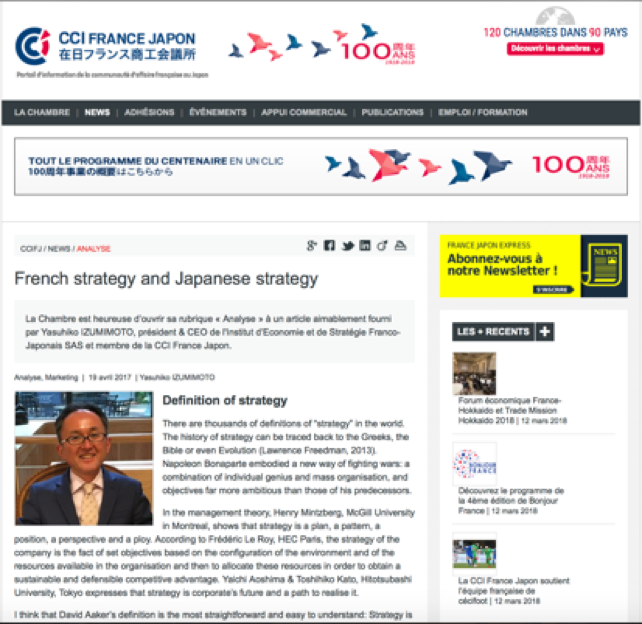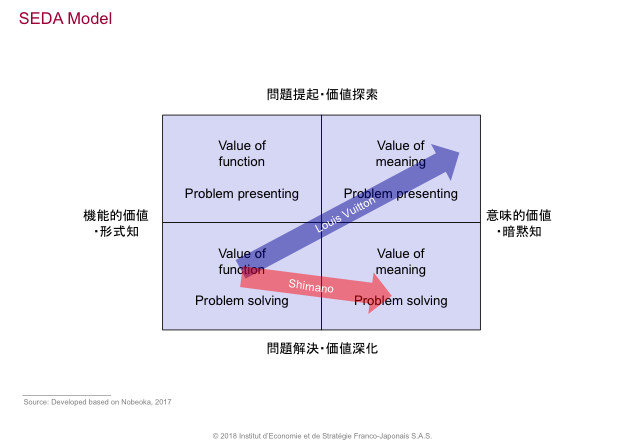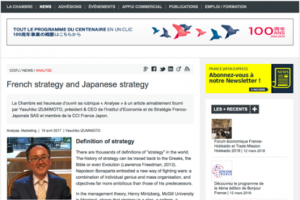(http://www.ccifj.or.jp/news-japon/analyse/vue-detail/n/52164/french-strategy-and-japanese-strategy/)
There is a column called “Analyse” on the homepage of the French Chamber of Commerce in Japan of which our company is a member, and I once posted an article about the differences between the French and Japanese strategy and I would like to share the article with you. I wrote my personal opinions based on the previous experiences as the president of a consulting company in Paris where I provided consulting services to both French and Japanese companies for five years. First of all, let me draw two examples.
In 1835, a 14-year-old boy who grew up in the mountains of Jura, France, travelled 400 km to Paris over the two years, refined his techniques, then gained the trust of Princess Napoleon III. It led him to open a traveling trunk shop in Paris. His name is Louis Vuitton. After 120 years, the young generations began purchasing lightweight luggage that does not require a porter, and this business started declining. In order to overcome the difficulties, they fulfilled the integration with Möet Hennessy which traded Champagne and Brandy, and formed LVMH in 1987. LVMH continues to grow over time. The success of Louis Vuitton is thought to be due to the persistent pursuit for the genuine product quality, the provision of the absolute value, and the succession of the legend.
In Japan, Shozaburo Shimano established a company that manufactures freewheels for bicycles in Sakai, Osaka in 1921. In 1957 they began researches on the production of a 3rd speed hub and cold forging, and began exporting the products to the United States in the 1960s. After years of tough competition against the American companies and the effort to wipe out the bad brand images for the Japanese products, they gradually gained trust. What is more, they won the prestige premium market: they opened a bicycle exhibition in Milan, Italy, and participated in Tour de France. As a result, they became a highly profitable manufacturer representing Japan today. Shimano is differentiated in 3 ways: product innovation through its own integrated product as seen in Dura Ace and 105, thorough end-user orientation, and human-oriented management.
These two companies have important similarities. First of all, it was a pursuit of products of genuine quality as seen in the fight against imitated goods. Secondly, to meet customer expectations, they urge to exceed them, and thirdly, they constantly make efforts to keep the strong brand images through researches, product development, production, sales, and after-sales services.
On the other hand, there are differences in their approaches that seems to come from the cultural differences between France and Japan. I will attempt to elaborate on the differences through the Kentaro Nobeoka of Hitotsubashi University model (SEDA model). They share the starting point (the lower left) in the matrix as both Louis Vuitton and Shimano prioritised the improvement on the functional values of travelling bags and bicycle parts so as to solve the problems the (potential) customers faced. In addition, both companies endeavour to communicate the values that the brands will bring to the customers through series of sophisticated marketing campaigns which make them shift towards the right of the matrix. However, what they emphasised in the process differed from each other.
What this might mean is that the definition of the issues they want to solve differ. The issue that Shimano aspires to solve is how to allow smooth and speedy change in gears for both professional and non-professional customers, or to realise a natural shift. Although they excel in manufacturing high quality products compared to when the company started, the underlying issues that they tackle has never changed from its inception. Yet, the issues defined by Louis Vuitton has not remained consistent but has become more intrinsic. The differences between what the travellers carried a couple of decades ago and what they carry today do not remain relevant to them. They ask themselves more fundamental questions such as “what the travellers crave after trips”, and “what makes trips more fulfilling” and they address such questions in the strategy.
Why do we go on a trip, what are you looking for in a trip, what is the world around in your daily life like, and what expectations do you have for a trip? Depending on the answer to such questions, the solution cannot be provided through the physical existence of a bag. A company needs to create values by asking themselves what the company can do to realise the happiness, joy and hopes for the customers. This is how I see how French companies develop game changing strategy.




